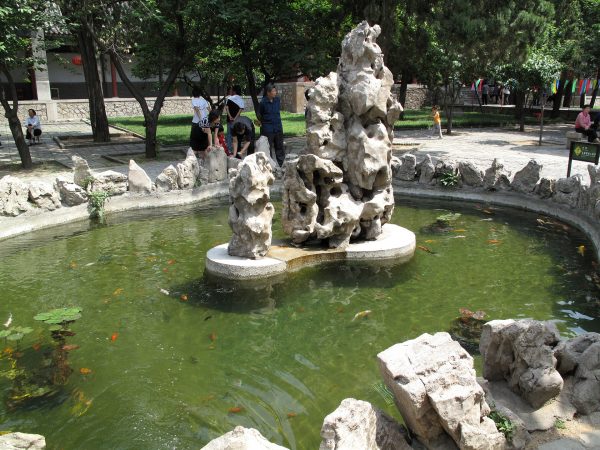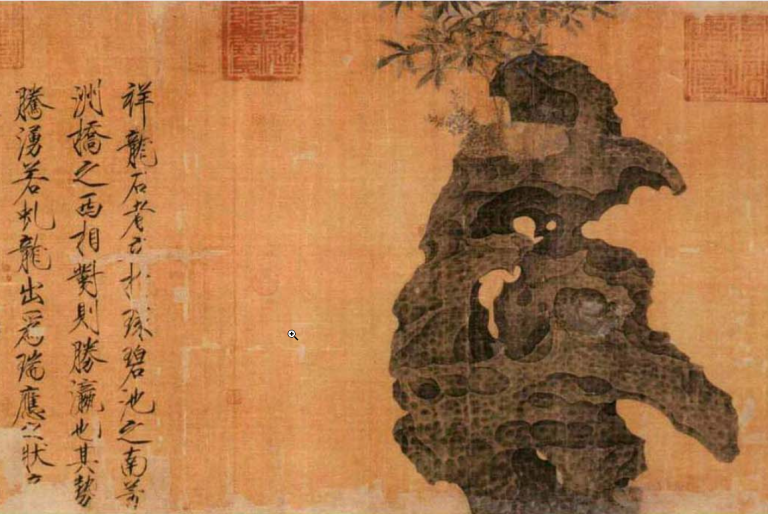The mountain holds a special place in Chinese art and philosophy, as men of learning attempted to convey the majesty, holiness, and eternity of the mountain as well as aesthetic ideals and spiritual manifestations. One of the eight divinatory trigrams, gen (艮), takes the mountain as its symbol, representing the result of completed action.
Mountain peaks can be represented not just in flat two-dimensional paintings, but in three dimensions by shaped rocks or stones. For centuries, Chinese scholars have collected unusually shaped rocks to enhance their gardens or decorate their studies. These so-called scholar’s rocks, or spirit stones, can be massive, weighing hundreds of pounds, or be lighter than a pound. In Chinese, scholars’ rocks are known as gongshi (供石).
Gongshi are not just any rocks. They are composed of limestone which has been worn away by water. Limestone is partially soluble in water; the solubility is increased if the water contains a little acid, usually carbonic acid derived from the carbon dioxide in the atmosphere.
On a large scale, erosion of limestone is responsible for huge caves, such as the Carlsbad and Luray Caverns. On a smaller scale, the water nibbles at the surface of a rock, creating pores, channels, depressions, tiny grottoes, miniature caverns, all in striking shapes. The watery yin acts on the stony yang.
READ MORE:
- Ancient Chinese Pest Control – Without Insecticides
- The Legendary Origins of Chinese Acupuncture
- The Past–And Present–of China’s Imperial Exams

Famous gongshi are sourced from just three places in China, which adds to their value and distinctiveness:
Success
You are now signed up for our newsletter
Success
Check your email to complete sign up
Lingbi stones (靈璧, literally “spirit jade) come from the northern Anhui Province. They are dense, deep black, and glossy. They are naturally resonant, producing a pleasant sound when struck.
Yingde stones (英德) are from caves in Yingde county of Guangdong Province They tend to be thin and slender; their surfaces are marked with twisted furrows, folds, wrinkles and lines, all properties favored by collectors.
Taihu stones (太湖) originate in Jiangsu Province from unique limestone formations at the foot of the Dongting Mountain, which are subject to surging water from the adjacent Lake Tai, now sadly polluted. Some rocks were drilled then immersed in the lake for hundreds of years.
Scholars have been collecting these rocks for more than a thousand years, and continue to do so today. Just recently, Wan-go H. C. Weng donated his collection to Boston’s Museum of Fine Arts. In 2015 at Christie’s in Hong Kong, a rock from the “Beyond White Clouds” collection sold for $38,891.
Qualities of the scholar’s rock

What qualities make a rock especially prized or valuable? Early on, in the Tang Dynasty, 618 to 907 A.D., the presence of thinness, openness, perforations, and wrinkling were pronounced desirable qualities.
Other favorable properties include color, texture, shape, markings, resonance of sound when struck, age, and geographic origin. Shape is important: prominent overhangs or an inverted pyramidal shape are commendable if the overall balance is maintained. Any resemblance to a dragon, or to an animal, human or other natural structure is interesting. Smooth areas that can be stroked are nice.
- A Fate Preordained: The Rise and Fall of Zhou Yafu, Prime Minister of Han
- Traditional Chinese Architecture – The Siheyuan
Hollows and perforations provide dramatic contrast to the solidity of the stone, recalling the concepts of emptiness and nothingness found in Confucian theory. For the scholarly owner, Gongshi are a representation of nature, a stimulus for meditation and a source of aesthetic pleasure.
From its shape, the rock can exude spiritual energy that the fortunate scholar may absorb. The stones, avatars of mountains, helped the scholar imagine the sacred peaks of faraway mountain ranges where the spirits dwell. The seemingly eternal hills reflect the longevity of human existence. Such a stone becomes a microcosm of the whole world.
Even if we cannot afford the intricately eroded rocks from exotic Chinese locales, we can find, collect, and enjoy interesting stones and rocks for ourselves. They can evoke the beauty, harmony, and mystery of our natural world.












